Washington: Originally scheduled for October 31st, the planned six-month mission was delayed as Elon Musk-run SpaceX evaluates off-nominal behaviour of Falcon 9 first stage engine gas generators observed during a recent non-NASA mission launch attempt.
The SpaceX Crew Dragon Resilience spacecraft will carry four astronauts to the International Space Station as part of NASA's Commercial Crew Programme.
"With the high cadence of missions SpaceX performs, it really gives us incredible insight into this commercial system and helps us make informed decisions about the status of our missions," said Kathy Lueders, associate administrator of NASA's Human Exploration and Operations Mission Directorate.
"The teams are actively working this finding on the engines, and we should be a lot smarter within the coming week," Lueders said in a statement.
NASA's SpaceX Crew-1 mission will launch NASA astronauts Michael Hopkins, Victor Glover, and Shannon Walker, along with Japan Aerospace Exploration Agency (JAXA) mission specialist Soichi Noguchi, from Launch Complex 39A at NASA's Kennedy Space Center in Florida.
After launch, Crew Dragon will perform a series of maneuvers culminating with rendezvous and docking with the space station.
That milestone will mark the Crew-1 astronauts' integration with the Expedition 64 astronauts Kate Rubins, as well as Expedition 64 commander Sergey Ryzhikov and flight engineer Sergey Kud-Sverchkov, both of the Russian space agency Roscosmos.
During their stay on the orbiting laboratory, astronauts of Crew-1 will see a range of unpiloted spacecraft including the Northrop Grumman Cygnus, the next generation of SpaceX cargo Dragon spacecraft, and the Boeing CST-100 Starliner on its uncrewed flight test to the station.
They also will conduct a variety of spacewalks and welcome crews of the Russian Soyuz vehicle and the next SpaceX Crew Dragon in 2021, NASA said.
At the conclusion of the mission, Crew Dragon will autonomously undock with the four astronauts on board, depart the space station and re-enter the Earth's atmosphere.
Also Read: Nobel Prizes 2020
(Inputs from IANS)



